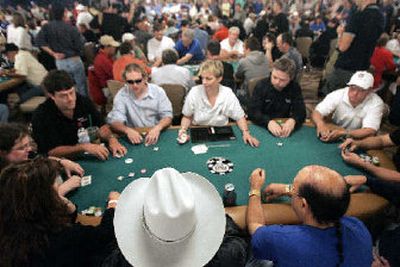More air time for poker

LAS VEGAS – Stop. Do Not Enter. Emerald City.
Only the two wizards monitoring screens behind the black curtain where those signs were posted could see the hole cards of the players at the final table of the World Series of Poker on Friday.
The rest of the poker-mad universe will have to wait until ESPN shows the finale of the series on Nov. 15 to see what those cards were, who was bluffing and who wasn’t.
There won’t be any suspense about who won the $7.5 million prize and No Limit Texas Hold ‘em championship bracelet, but that probably won’t stop several million players and fans from tuning in to see every nuance of the action.
ESPN’s 22-part series last year was viewed by an average of more than 1.5 million households – a 42 percent increase from the network’s 2003 seven-part series. This year, the series that starts July 19 will include a nearly 50 percent increase in coverage from a year ago – two hours of poker every Tuesday night for a total of 32 hours, starting with six episodes from the World Series of Poker Circuit.
Beginning Aug. 23, 14 episodes will focus on the world championships of various poker games, including Limit Hold ‘em, Seven-Card Stud, Pot Limit Omaha and No Limit Hold’em. From Oct. 11 to Nov 15, the series’ last 12 back-to-back one-hour episodes will be dedicated to the $10,000 buy-in No Limit Texas Hold ‘em main event, culminating in the winning hand at the final table.
“Last year the World Series of Poker had higher ratings than everything on ESPN except the NFL and NASCAR,” director of tournament operations Gary Thompson said. “I expect the ratings will be higher this year because of the greater size of the purse, the greater number of players and the momentum the game has built. It’s been growing incredibly.”
Poker is one of the few games where watching on television is better than watching it live. The 300 or so spectators packed around the final table at Benny’s Bullpen at Binion’s Gambling Hall & Hotel could cheer the winners of big pots, see the flops, turns and river cards but could view the hole cards only when the players showed them. Without seeing those and without commentary from experts, it was impossible to tell exactly what was going on.
That won’t be the case when ESPN finishes distilling some 2,000 hours of videotape into the final, slickly packaged product. The editing alone takes at least two weeks per show.
“The important thing is finding the winner at the earliest point you have them in the tournament, backtracking to that point, and then start weaving them in,” said Bob Chesterman, ESPN’s coordinating producer of the shows. “But we still cover each show as if our plan of action was that day. We don’t really change course when we go to produce it. Trying to get that one person who wins in there is tough because most likely they’re not at a featured table each day.”
The main event, which started last Wednesday, drew a record 5,619 players. It was impossible to know, until the semifinal round ended at 3:05 a.m. Friday, which nine players would sit at the final table 13 hours later. So ESPN had cameras roaming the huge card room at Harrah’s Rio as well as cameras trained on the players at the featured table each day – 13 to 15 hours a day.
The cameras caught the play of a geisha from Japan, a few Hollywood celebrities, a 91-year-old man who was the oldest player, the amateurs and online players who unexpectedly reached the late stages, and the ranting of pro Phil Hellmuth when he was knocked out in the first round. ESPN, which had a 40-person crew and 22 cameras on the set, will weave in those scenes and dozens of others, along with profile pieces and commentary to create a series that should be far more compelling than the view spectators had in Las Vegas.
“We’re looking for closer shots, more cinematic shots, so that’s why we shoot it the way we do with the dolly,” Chesterman said. “Most of the shooters are not sports cameramen, they’re film guys. At the main table, there’s 10 tiny cameras inside the table along the arms, one camera underneath, two above, and five cameras around.”
ESPN’s audience is typically the 18-to-34-year-old age group, more male than female, network spokeswoman Keri Potts said.
“With poker, the 25-to-54-year-old range is really strong for us,” she said. “The show does phenomenally well in both those demographics. And we’re getting more female viewers than other sports. Someone asked if I thought the poker fad’s almost over. I don’t think this is a fad. I think this is now going to be in the mainstream.”